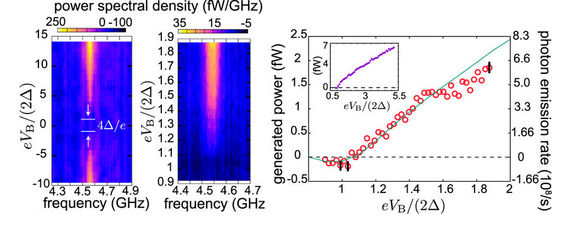Superconducting quantum electronics

Introduction
We develop components and methodology in the rapidly growing field of quantum computing, especially in the framework of circuit quantum electrodynamics (cQED). Our experiments with superconducting circuits are strongly supported by our quantum theory effort. In quantum computing, we focus on developing a multi-qubit quantum processor in the recently started quantum computer project, see press release. Such computers are potentially useful in solving complex problems such as those related to nitrogen fixation, machine learning, or cryptology. In the cQED experiments, we focus particularly on the interplay of thermal and electric effects [Nat. Phys. 12, 460 (2016)], and dissipation and driving. Especially, we study the coherence properties of quantum circuits coupled to tunable environments [Nat. Comm. 8, 15189 (2017),arXiv:1712.10256]. In addition, we develop components for on-chip manipulation of light at microwave frequencies [Sci. Rep. 7, 14713 (2017)]. Such components are important, for example, for quantum computing and communications based on propagating microwave photons.
Quantum computer project
In the quantum computer project, we develop a scalable quantum computer together with several other research groups at Aalto University, see press release. This project works in close collaboration with the Finnish Centre of Excellence in Quantum Technology (QTF) and the state-of-the-art cleanroom and low-noise measurement facilities of OtaNano. The goal of the project is to develop a multi-qubit quantum processor. We focus on transmon qubits which combine long coherence times and flexible coupling mechanisms to different types of quantum circuits. In first experiments, we have measured energy relaxation times of tens of microseconds for Xmon style qubits fabricated in Aalto’s Micronova cleanroom facilities.

Figure. (a) Photo of a centimeter-sized silicon chip, which has three separate superconducting qubits. (b) For one of the qubits, we measure an energy relaxation time of 19 µs.
Tunable environments for superconducting circuits
Based on our above-mentioned efforts on superconducting qubits, we study tunable environments for superconducting circuits. Our idea is to couple the qubits to the recently developed quantum-circuit refrigerator (QCR) [Nat. Comm. 8, 15189 (2017)] (see video) or to a tunable heat sink [arXiv:1712.10256]. The operating principle of the QCR relies on voltage-controlled photon-assisted single electron tunneling. The tunable heat sink works with a dissipative element coupled to a quantum circuit, where the coupling strength is tunable through the relative detuning. By coupling a qubit to such devices, we aim to implement our theoretical ideas on a fast qubit reset [NPJ Quant. Inf. 3, 27 (2017)] and engineered environments for superconducting quantum systems [Phys. Rev. B 96, 094524 (2017)]. Our goal is to use such experiments for noise-enhanced quantum control experiments and to scale up the number of qubits to simulate dissipative open quantum circuits and complex Hamiltonians.
Recently, we also implemented a thermal source of microwaves using a QCR coupled to a resonator [Sci. Rep. 8, 3966 (2018)]. By applying a large voltage on the tunnel junctions of the QCR, it starts to operate as a high-temperature environment as opposed to a low-temperature environment at low bias voltages. Consequently, we were able to measure a large flux of photons emitted from the resonator.

Figure. Power spectral density and total generated power measured from a QCR-coupled resonator as a function of the bias voltage of the QCR tunnel junctions [Sci. Rep. 8, 3966 (2018)]. At high voltages there is a clear spectral brightening at the resonator frequency and in the vicinity of the gap voltage we observe refrigeration of the resonator mode. Figure credit: Shumpei Masuda.
Heat conductance over macroscopic distances
We have experimentally studied heat conduction between two normal-metal blocks terminating the opposing ends of a superconducting transmission line at sub-kelvin temperatures [Nat. Phys. 12, 460 (2016)]. The length of the transmission line is up to a meter, and the electron temperatures of the normal-metal blocks are measured with NIS thermometry. Such devices can potentially be utilized, for example, in remote cooling of very sensitive components in cryogenic detectors. Interestingly, we measured a heat conductance close to the quantum of thermal conductance in this single-mode channel thus extending the lengths in previous observations by several orders of magnitude. See also our blog post on this.

Figure. Sample structure and measurement scheme in our publication [Nat. Phys. 12, 460 (2016)]. The electron temperature of the right resistor is controlled with an external voltage while the temperatures of both resistors are measured. Microwave photons transport heat through the spiraling transmission line. Figure credit: Matti Partanen.
Phase shifter for microwaves
We demonstrated on-chip, flux-tunable, linear phase shifter based on three equidistant superconducting quantum interference devices connected by transmission lines [Sci. Rep. 7, 14713 (2017)]. We showed that such phase shifter can have high tunability while maintaining unit transmission. The phase shifter can be in principle combined with beam splitters and nonlinear phase shifters to realize a universal set of quantum gates for propagating microwave photons. So far, no promising candidates for nonlinear phase shifters have been experimentally demonstrated. However, in our theoretical studies, we have found that if the SQUIDs are replaced with qubits, our phase shifter design exhibits strong nonlinearity [arXiv:1703.02241].
We recently implemented a broadly tunable phase shifter for microwaves and studied it both experimentally and theoretically. By tuning the magnetic fluxes through the SQUIDs, we have observed significant phase shifts throughout a 280-MHz bandwidth from 6 GHz to 6.28 GHz [AIP Advances 10, 065128 (2020)].
More immediate applications for the phase shifter are found in the control and measurement side of quantum computation. It can be used, for example, to tune the phase of on-chip microwave source, thus possibly allowing control of many qubits with only single off-chip microwave source.

Figure. (a) Electric circuit diagram of our phase shifter based on three equidistant SUIQDs and (b) illustration of the sample and measurement scheme. Figure credit: Roope Kokkoniemi / [Sci. Rep. 7, 14713 (2017)].






